Castile and Leon coins catalog with values
Kingdom of Castile and Leon
dinero
Alfonso X (1252-1284)
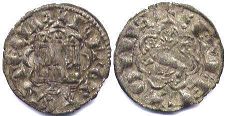
noven (9 dinero) no date
silver
MONETA CASTELLE
ET LEGIONS
Value - 25-30 USD

maravedi "black" (1/2 maravedi) no date
billon
ALF REX CASELL
ET LEGIONIS
Value - 20-25 USD
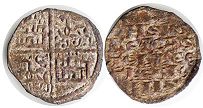
dinero no date
billon
ALFONSVS REX CASTELLE ETLEGIONIS
Value - 10-15 USD

obol (1/2 dinero) no date
billon
LEGIONIS
CASTELLE
Value - 10-15 USD
Sancho IV (1284-1295)
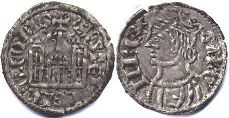
cornado noven (9 dinero) no date
billon
CASTELLE LE GIONIS
SANC II REX
Value - 30-35 USD
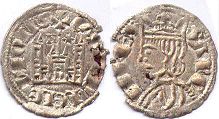
cornado noven (9 dinero) no date
billon
CASTELLE LE GIONIS
SANC II REX
Value - 30-35 USD
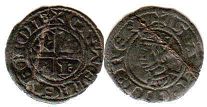
cornado seisen (6 dinero) no date
billon
CASTELLE LEGION
SANCII REX
Value - 30-35 USD
Ferdinand (Fernando) IV (1295-1312)
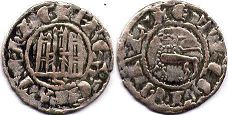
pepion (dinero) no date
billon
F REX CASTELLE
ET LEGIONIS
Value - 15-20 USD
Alfonso XI (1312-1350)
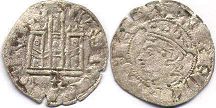
cornado noven (9 dinero) no date
billon
CASTELE LEGIONIS
ALFONSVS DO GRA R
Value - 25-30 USD
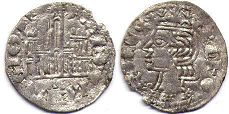
cornado noven (9 dinero) no date
billon
CASTELE ET LEGIONIS
ALFONS REX
Value - 25-30 USD
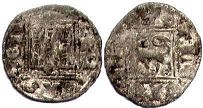
noven (9 dinero) no date
billon
ALF REX CASTELLE
ET LEGIONIS
Value - 10-15 USD
Henry (Henrique) II Trastamara (1366-1367 and 1369-1379)
The struggle to enthrone the new dynasty of
Trastamar is one of the most famous struggles in Spanish
history, in no small part because it involved France and
England.
Enrique (1334-1379) was the son of Alfonso XI by Leonora de
Guzmán, and was given the earldom of Trastamar at birth.
Bastards were not considered in any way inferior and certainly
did not consider himself as such Enrique - the eldest of the
surviving illegitimate sons of Alfonso. He was, incidentally,
two years older than the legitimate heir, Pedro I.
Pedro I, having ascended the throne, had turned many against
him, including the Pope (because he openly lived with his
mistress, Maria Padilla) and France (because he equally openly
neglected his lawful wife, Blanca of Bourbon). Enrique naturally
became the head of the king's opponents, especially since he
began his reign with the execution of Leonora Guzmán.
The war continued with mixed success until Enrique was joined by
French mercenaries (rutiers), which Charles V cleverly alloyed
to Spain from France, where they were engaged in robbery, and to
command this gang sent the best commander of the time Dugeklen.
Together the allies occupied several important cities, Pedro
fled and on May 5, 1366 Enrique was proclaimed king.
Pedro soon returned with English troops led by Edward the Black
Prince. England was much closer to Spain then than it is now.
Edward was the Duke of Aquitaine (or Guienne), a part of France
with the main city of Bordeaux. The English were interested not
only in the money and territories Pedro had promised them, but
also politically - the Hundred Years' War was going on, and
France was supporting Henrique. In the end, the Black Prince
won, Pedro became king again, but he did not give what he had
promised to the English.
Edward returned to Guienne, having lost part of his army and his
own health, and when Enrique returned with a new French army,
there was no one to defend Pedro. Defeated in a decisive battle,
he entered into negotiations with Dugueclain and during this
meeting, was stabbed by Henrique in a duel (1369). The duel did
not seem to be entirely fair - one of Trastamara's companions
held Pedro's leg. But in general, Enrique looks much more
sympathetic in this long confrontation. Actually, Pedro's
nickname - "Cruel" also says something, given that in those days
few people could boast of a good temper. Apparently, the former
king stood out even against such a background ...
The King's defeat didn't end the war. Taking advantage of the
devastation of Castile, neighbors - from Aragon and Portugal to
the successor of the Black Prince John of Gaunt, tried to
appropriate the lands left unattended. Gradually, with French
help, these attempts were thwarted, but real peace came near the
end of Enrique's reign.
The activity of Trastamara in peacetime does not give the right
to call him an outstanding ruler, but everything that could be
done in such a difficult time he did.
Trying to attract allies, the king generously gave away lands
and privileges, for which he was nicknamed "Merciful" by his
contemporaries, and his heirs were later repaid for this
generosity.
Enrique has the dubious honor of organizing the first Jewish
pogrom (Toledo, 1355).
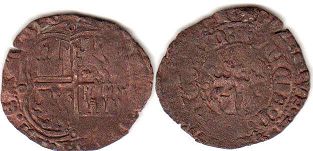
3 maravedis no date
billon
DOMINVS MIHI ADIVTOR ET EGO DI PISCAN INIMICOS MEOS / E N
ENRICVS REX CASTELLE E LEGIONIS
Value - 30-35 USD
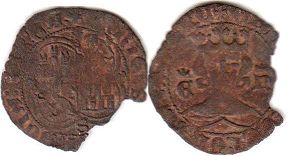
1/2 maravedi
billon
ENRICVS DEI GRACIA REX CASTE
ENRICVS DEI GRACIA REX CASTE / E N
Value - 30-35 USD
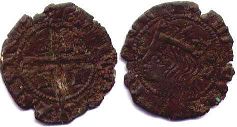
cruzado (10 dinero) no date
billon
ENRICVS REX CASTELLE / ENRI
ENRICVS REX LEGIONIS
Value - 15-20 USD
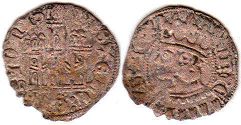
cornado (9 dinero) no date
billon
CASTELE E LEGIONI
ENRICVS REX
Value - 15-20 USD
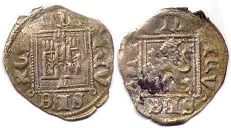
noven (9 dinero) no date
billon
ENRICVS REX C
ENRICVS REX C
Value - 15-20 USD
John (Juan) I (1379-1390)
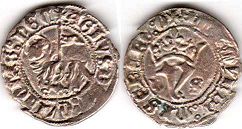
blanca (1/4 real) no date
silver
AGNVS DEI QVI TOLIS PEC
CATA MVNDI MISERERE NOBIS
Value - 35-45 USD
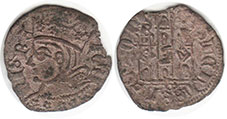
cornado (9 dinero) no date
billon
IOHANIS REX
CASTELE E LEGIONI
Value - 30-40 USD
Maravedi=2 dinero; Blanca=4 dinero
Henry (Henrique) III (1390-1406)
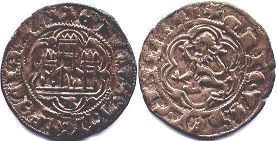
blanca no date
billon
ENRICVS DEI GRACIA REX
ENRICVS DEI GRACIA REX
Value - 20-25 USD
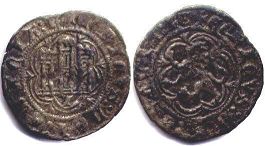
blanca no date
billon
ENRICVS DEI GRACIA
ENRICVS DEI GRACIA RE
Value - 15-20 USD
John (Juan) II (1406-1454)
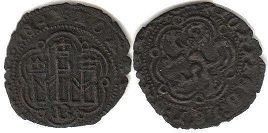
blanca no date
billon
IOHANES DEI GRACIA REX
IOHANES DEI GRACIA REX CA
Value - 15-20 USD
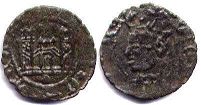
cornado nuevo (1/2 blanca) no date
billon
IOHANES DEI GRACIA
IOHANES DEI GR
Value - 15-20 USD
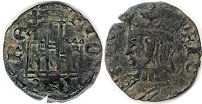
cornado nuevo (1/2 blanca) no date
billon
IOHANESREX
IOHANES DEI GR
Value - 15-20 USD
Henry (Henrique) IV (1454-1474)
Enrique's nickname "El Impotente" sounds
somewhat ambiguous, but, it simply means "The Impotent", in
every sense. The version of male impotence was discussed mainly
by opponents of the king, in order to remove his daughter Juana
from the succession. In general, the option of impotence is also
possible, given that only one child was born from two wives, and
that the rumor attributed not to the king, and a courtier
Beltran de la Cueva, why the girl was called Juana Beltraneha.
The main reason for the unflattering nickname is that the king
had to constantly yield to the claims of the nobility. In 1464
he was forced to recognize the heir of his younger brother
Alfonso, instead of Juana, but it did not suit everyone. Part of
the aristocrats gathered in Avila (1435) and proclaimed Alfonso
king, while building a puppet of Enrique and depriving her of
the signs of royal dignity - the so-called "farce in Avila.
Another group of nobles supported Enrique.
The struggle continued with mixed success until 1468, when
Alfonso died. The boy was 14 years old, the cause of death is
not known.
The new direct heiress recognized Enrique's sister Isabella, and
one of the conditions was the requirement for her not to marry
without the consent of the king. This condition was broken in
1469, when Isabella secretly married Fernando, the heir to the
Aragonese throne, as a result of which the king again declared
Juana heir. The war resumed and continued until the death of
Enrique (the cause of his death is also unknown).
The future Queen Isabella (the king's sister) considered it
unseemly to pry into the king's private life and prudently held
the view that Juana could not be considered a legitimate
daughter because the royal marriage had not been specifically
authorized by the pope, as it was supposed to be for close
relatives.
After Enrique IV's death, the war continued for another five
years - Juana was supported by her uncle and concurrent husband,
King Alfonso V of Portugal. In the end, the marriage was
annulled by the Pope because of the close kinship of the couple,
and Juana spent the rest of her life in a convent.
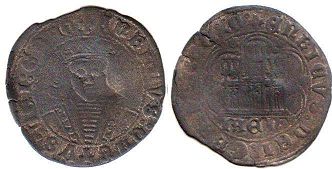
Quartillo (1/4 real=8,5 maravedi) no date
billon
ENRICVSCARTVSDEI GRA
ENRICVSDEI GRA REX C / IAEN
Value - 40-50 USD
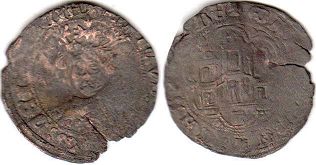
Quartillo (1/4 real=8,5 maravedi) no date
billon
ENRICVSCARTVSDEI GRACIA
ENRICVS REX CASTELLE
Value - 35-40 USD
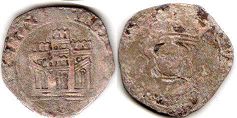
1/2 quartillo no date
billon
ENRICVS DEI GRACIA REX
ENRICVS QVARTVS REX CAS
Value - 25-30 USD
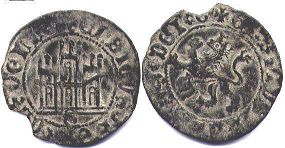
2 maravedi no date
billon
ENRICVS REX CASTELLI
ENRICVS CARTVS DEI G
Value - 40-50 USD
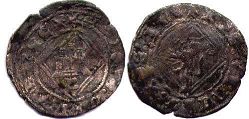
dinero no date
billon
ENRICVS DEI GRA REX
XPS VINCIT XPS REG
Value - 10-15 USD
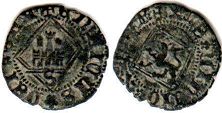
dinero no date
billon
ENRICVS DEI GRACIA
XPS VINCIT XPS
Value - 10-15 USD
Isabella I and Ferdinand V (1479-1504)
The marriage of Isabella (1451-1504) and
Ferdinand (1452-1516), heirs to the Castilian and Aragonese
thrones, respectively, took place in 1469 in secret from King
Enrique IV, which contravened a treaty with him and caused a war
of succession.
The two young men saw each other shortly before the wedding, so
love was out of the question, but they ruled in harmony.
Ferdinand was initially assigned the role of Prince Consort (and
under the treaty he was forbidden to leave Castile and generally
do anything without the consent of his wife), but on Isabella's
initiative a completely different agreement was concluded,
according to which the spouses became equal rulers and any
document had to be sealed with two signatures. After Isabella's
death, Ferdinand ruled as regent until his own death.
Contrary to popular belief, the dynastic union of Castile and
Aragon (Ferdinand became king of Aragon in 1479) did not mean
the formation of the Spanish kingdom. Both Castile and Aragon
had their own governments and continued to pursue completely
independent policies, including even economic ones. Customs
posts on the border of Castile and Aragon remained in place
until 1700.
In the field of internal policy it should be noted the
establishment of the Holy Hermandad - a kind of city militia,
which was maintained at the expense of the state, but was
obliged not only to protect the peace of the citizens, but also
to serve as a militia for royal needs. This made it possible to
curb both the self-rule of the grands, and the willfulness of
urban communities.
The main political event of the reign was the end of the
Reconquista. By this time there was only one Muslim state left
on the territory of Spain - the Emirate of Granada. Formally,
the Emirate was a vassal of the Castilian crown and even paid it
a fairly decent tribute, but the feud still continued and border
skirmishes were almost constant.
After the end of the War of Castilian Succession, the army was
sent to Andalusia to avenge the sacking of the Castilian city of
Saara de la Sierra (1481). At the same time in Granada the son
of Emir Abdul-Hasan, Abu-Abdullah, or, as he was called by the
Christians, Boabdil, rebelled against his father. Having
unexpectedly gained such an ally, Ferdinand, who personally
commanded the army, decided not to confine himself to the
frontier war, but to try to capture the whole emirate.
Quite often this war is presented as a confrontation between
Christians and Muslims. In fact, the two had been living side by
side for several centuries and coexisted, in general, quite
peacefully. In Granada there were almost more Christians than
Muslims and vice versa, in Castile there were many
non-Christians (especially in the south of the peninsula).
Ferdinand was simply taking the path of least resistance - if he
had had the opportunity to conquer not Muslim Granada, but, say,
Christian Portugal, he would not have hesitated for a second.
But Granada did seem a very tempting target. In addition to
internecine warfare, the country was torn by petty feuds of the
local nobility, fighting with each other and with the Emir.
Nevertheless, the conquest was slow and difficult. In 1485 Ronda
was conquered, in 1487 Malaga. On January 2, 1492, after a siege
of eight months, Granada fell.
The terms of surrender were rather lenient. The local population
was not forced to change religion and was not disadvantaged in
any way compared to Christians. But that was only at first.
Further, the articles of the treaty were gradually canceled and
the citizens of the newly created kingdom of Granada tasted
"Catholic freedom".
Castile had a policy of oppressing foreigners. Isabella was a
fanatical Catholic and considered the persecution of
non-Christians a godly deed. In 1478, the "Tribunal of the Holy
Office of the Inquisition" was established. Ferdinand and
Isabella have the dubious honor of inventing the ghetto. The
name came later, but it was they who ordered the creation of
special closed urban neighborhoods for non-Christians.
After the capture of Granada, the "Edict of Alhambra" was
issued, ordering all Jews to either be baptized or leave the
kingdom. In 1502, the same fate befell the Moors.
But even baptism did not always eliminate persecution. Many
Marranos (baptized Jews) and Morrisks (baptized Muslims) were
accused of secretly following the faith of their ancestors and
were imprisoned or executed.
On October 12, 1492, the expedition of Christopher Columbus
(whose real name was Cristobal Colón), partly equipped at the
expense of the Kingdom of Castile, landed on one of the Bahamas
Islands. The conquest of the Americas had begun. But, during the
reigns of Isabella and Ferdinand, the newly discovered
territories did not yet generate any income.
The title of "Catholic Kings (Los Reyes Católicos) was given by
the Pope to Ferdinand and Isabella not for religious merit or
for expelling the Moors from Spain, as it may seem, but because
Spain supported the Pope in his struggle in Italy - Ferdinand
took from France the Papal Province and the Kingdom of Naples
(which was considered a feud of the Pope).
Real=34 maravedi; Maravedi=2 blanca
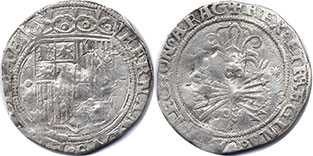
1 real no date
silver
FERNANDVS ET ELISABET
REX ET REGINA CASTELE GION AR
Value - 50-60 USD
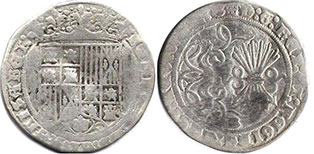
1 real no date
silver
FERNANDVS ET ELISABET
D G REX ET REGINA CASTELE GION AR
Value - 50-60 USD
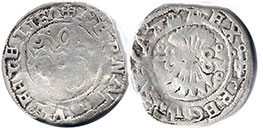
1/2 real no date
silver
FERNANDVS ET ELISABET
REX ET REGINA CASTELE GION AR
Value - 50-60 USD
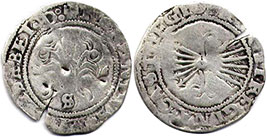
1/2 real no date
silver
FERNANDVS ET ELISABET D
REX ET REGINA CASTEL GION AR
Value - 50-60 USD
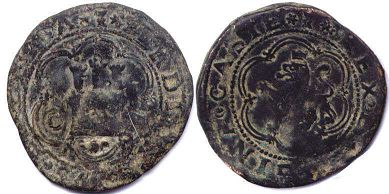
4 maravedi no date
copper
FERDINAND ET ELISABET
REX ET REGINA CASTE
Value - 25-30 USD
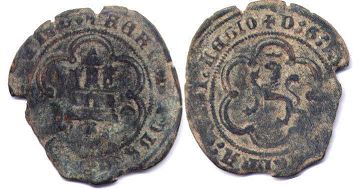
4 maravedi no date
copper
FERNANDVS ET ELISABET
D G REX ET REGINA CAST LEGIO
Value - 30-40 USD
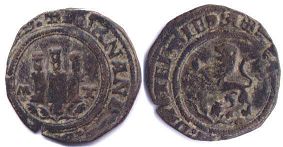
2 maravedi no date
copper
FERNANDVS ET ELISABET
D G REX ET REGINA CASTEL E LEG
Value - 15-20 USD
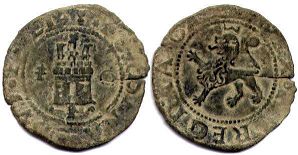
2 maravedi no date
copper
FERNANDVS ET ELISABET
REX ET REGINA CAST LEGION
Value - 20-25 USD
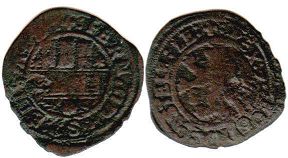
2 maravedi no date
copper
FERNANDVS ELISABET
REX ET REGINA CASTELE LE
Value - 15-20 USD
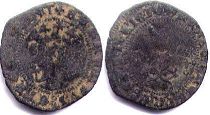
1 maravedi no date
copper
FERNANDVS ET ELISABET
REX ET REGINA CASTEL GION
Value - 15-20 USD
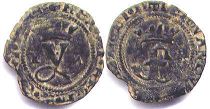
1 blanca no date
copper
Value - 10-15 USD
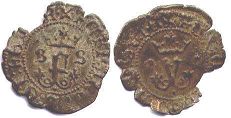
1 blanca no date
copper
Value - 10-15 USD
Coins of Castile and Leon in the catalog are presented divided by historical periods, indicating the main characteristics and differences by type.
Inside the sections, the coins are sorted by denomination - from large to small.
The cost of the coin is approximate and is indicated specifically for the coin shown in the picture. You can use this price to evaluate similar coins (of the same type), but remember that the value is affected by many factors, such as the state of preservation and the date of minting. The cost of coins of the same type can vary greatly depending on the number of surviving copies.
Coins of Castile and Leon presented on this page are not sold or bought - this is only a catalog.
